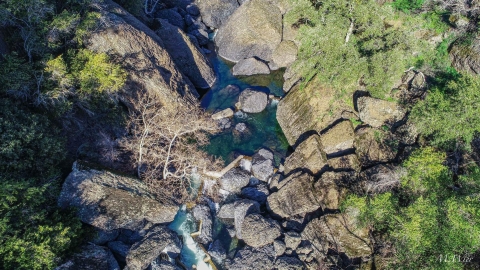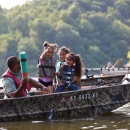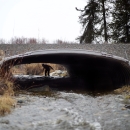States
CaliforniaThis four-year project will reconfigure instream boulders to create a natural fishway and restore access for spring-run Chinook salmon to the entirety of their historical distribution in Big Chico Creek, where an unmaintained 1950s fishway has created a barrier to upstream migration. In addition, non-salmonid native fish removed from the watershed in the 1980s will be relocated upstream of Iron Canyon to help them repopulate upstream habitats and restore ecosystem elements and processes. This project will improve watershed health, climate resilience, and recreational safety, and restore the culturally-important salmon population.
Project Quick Facts:
| Location | California |
| NFPP Project Funding | $3,815,372 |
| Restoration Techniques | Fishway |
| Partner Project Lead | California Trout |
The National Fish Passage Program combines technical expertise with a track record of success.
Implemented primarily through the Service's Fish and Wildlife Conservation Offices, the National Fish Passage Program provides financial and technical assistance to partners across the country. Since 1999, the program has worked with over 2,000 local communities, Tribes, and private landowners to remove or bypass over 3,400 barriers to fish passage fish passage
Fish passage is the ability of fish or other aquatic species to move freely throughout their life to find food, reproduce, and complete their natural migration cycles. Millions of barriers to fish passage across the country are fragmenting habitat and leading to species declines. The U.S. Fish and Wildlife Service's National Fish Passage Program is working to reconnect watersheds to benefit both wildlife and people.
Learn more about fish passage and reopen access to over 61,000 miles of upstream habitat for fish and other animals. Staff have expertise in fish migration and biology as well as financial, engineering, and planning assistance to communities, Tribes, and landowners to help them remove barriers and restore rivers for the benefit both fish and people.
Fish passage project proposals can be initiated by any individual, organization, government, or agency. However, proposals must be submitted and completed in cooperation with a Fish and Wildlife Conservation Office. (Please note that fish passage projects being used for federal or state compensatory mitigation or required by existing federal or state regulatory programs are not eligible for funding through the National Fish Passage Program.)
CONTACT A FISH PASSAGE COORDINATOR IN YOUR AREA TO GET STARTED.




